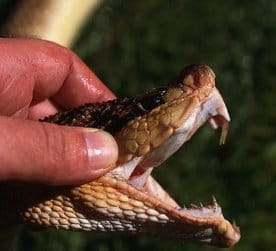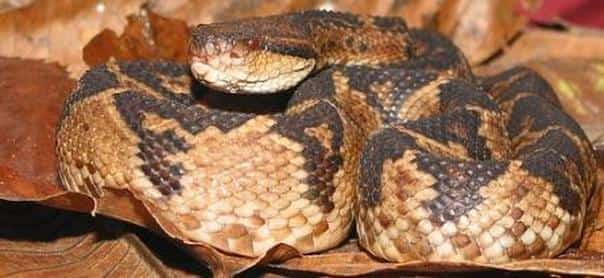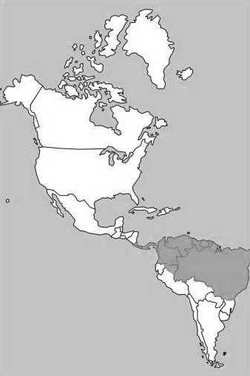BushmasterLachesis muta |

Custom Search
|
The preferred habitats maintain an average temperature of 75º F (24º C) or more and receive plenty of precipitation meaning they are usually only found below 3300 ft (1000 m).
The Bushmaster has a fierce reputation, known to aggressively attack, but actually, only a few human attacks have been recorded due primarily to their nocturnal nature. The bushmaster is a very large snake, with specimens often exceeding 6,5 ft (2 m) in length. But they can grow to be over 12 ft (3.5 m) making them the longest venomous snake found in the Americas. They exceed even the American eastern diamondback rattlesnake making them the largest pit viper in the world. They are also considered the 2nd longest venomous snake in the world after the king cobra (Ophiophagus hannah). The back color ranges from tan, yellowish, brown, gray, reddish or even a pale pink ground color, with distinct dark brown or black diamond-shaped markings down the back very often with yellowish edges. The belly is light colored. Usually, they have a darker stripe that extends from the mouth back corner to the eye. The bushmaster has heavily keeled and rough scales and there is a prominent dorsal vertebral ridge along the back. They have a thick cylindrical and tapered body, with a triangularly shaped head and narrow neck. They are not as heavy as heaviest rattlesnakes or other vipers, reaching weights around 6.6 to 11 lb (3 to 5 kg).
These extremely sensitive organs function as infrared heat sensors, enabling them to detect the body heat of their prey. This allows them to see the world in the visible spectrum of light like humans but also in the infrared spectrum.
Carolus Linnaeus named it Crotalus muta but the late 18th century herpetologist Francois-Marie Daudin assigned the bushmaster to its own genus, naming it Lachesis mutus. In Greek mythology, Lachesis is one of the three Fates and was supposed to assign the end of life to humans, and anyone bitten by a bushmaster is certainly closer to dying. The Bushmaster scientific name when translated from Latin means literally "Silent Death". The species specific name muta refers to the fact that in a fashion similar to rattlesnakes the bushmaster vibrates its tail vigorously when alarmed. But since it has no rattle was called muta which is Latin for mute. Actually, their action makes quite a loud noise. The bushmaster is also known by many other names along its range, shushúpe in Peru, mapepire zanana in Trinidad, surucucu in Brazil, pucarara in Bolivia, cuaima in Venezuela and in Colombia it's known as verrugosa. Their lifespan in the wild isn't known but in captivity, they live for 12 to 18 years. Subspecies Two former subspecies (L. m. melanocephala / L. m. stenophrys) are now recognized as species, so there are 2 only subspecies currently recognized. Atlantic Forest bushmaster (Lachesis muta rhombeata) - Found in the coastal forests of southeastern Brazil ranging from the southern Rio Grande do Norte to Rio de Janeiro). South American bushmaster (L. muta muta) - Found in several south American countries like Peru, Colombia, Nicaragua, Panama, northern Bolivia, eastern Ecuador, eastern and southern parts of Venezuela, Trinidad, Guyana, French Guiana, Surinam and northern Brazil. 
Venom / Bite
The bushmaster venom like that of other vipers is a complex cocktail of toxic chemical compounds, which the primary function is to immobilize prey. The species produces a large amount of venom, but not as toxic when compared to some other viper species. A bushmaster is capable of producing up to 8 times more venom than the average American copperhead (Agkistrodon contortrix). They have very long fangs, although not as long as those of the Gaboon Viper with 2.5 inches. These remain folded inside the mouth until the snake bites, then they act as hypodermic needles penetrating in the victim, allowing the snake to inject venom very deeply. The Bushmaster venom has powerful haemotoxic properties and it affects the circulatory system, destroys the red blood cells, causes organ degeneration and massive tissue damage, if left untreated a bite will usually be fatal. Other effects include vomiting, severe pain, nausea, and chills. From the few bite records available suggest an 80% mortality rate in humans, making the bushmaster the deadliest snake in the Americas. Diet / Feeding The bushmaster is a nocturnal or crepuscular ambush predators, they eat mostly small mammals, such as rodents, primarily rats, and mice. On occasion, they will take birds or even reptiles The bushmaster is a ground-dwelling sit-and-wait type predator, concealing themselves relying on their cryptic coloration and markings for concealment, and wait for an animal to come within striking range. Reproduction The bushmaster is a solitary snake except during mating season, the male finds females by following a scent trail. The bushmaster reaches sexual maturity at about 4 years of age. The bushmaster is an oviparous snake species, females will typically lay a clutch of 5 to 19 eggs in an abandoned burrow. The eggs are whitish in color and only slightly larger than chicken eggs. The eggs have an incubation period of around 60 to 80 days, and the female much like birds broods the eggs. The female coils itself around the eggs guarding them until they hatch, she will not leave the nest not even to hunt. They are the only egg-laying pit viper found in the in the New World. At birth, the hatchlings measure approximately 11 to 20 inches (30 to 50 cm). They have a very bright yellow or orange tail tip, which is used to lure prey, this will fade over at 1 or 2 years old with the adult coloring. Conservation / Threats The bushmaster is listed as vulnerable under the IUCN Red List due to habitat destruction. The massive destruction and degradation of South American tropical rain forests is a major threat to the bushmaster and also many other animals and plants. Their population in the wild is unknown, the dense forests and some very difficult terrain they inhabit combined with their secretive nature make study them very difficult.
|
Did You Know?
The Mojave rattlesnake venom is regarded as the most toxic of any rattlesnake because of the presence of the "Mojave toxin". Scientific classification |
© 2014 Snake Facts About Us | Privacy Policy | Contact






